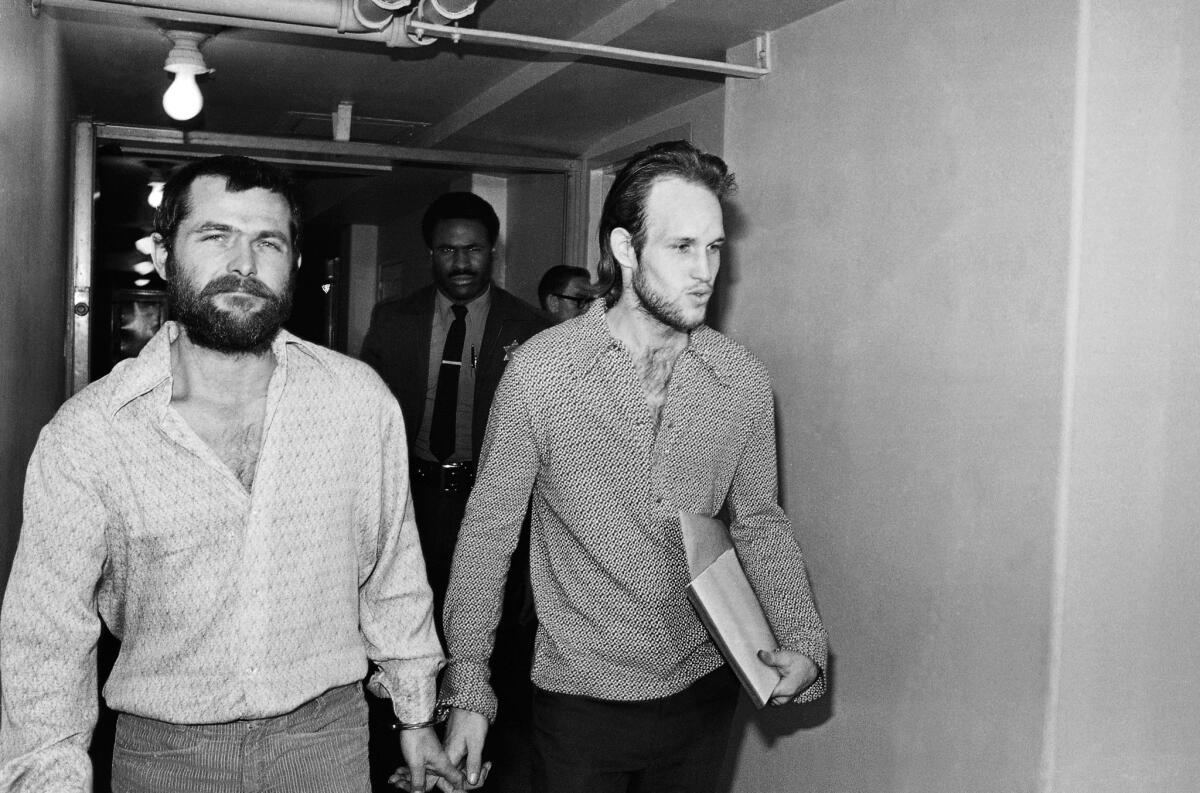Gov. Jerry Brown denies parole for Manson family member

- Share via
Reporting from Sacramento — Charles Manson associate Bruce Davis, convicted for his part in killing two of the nine people slain by members of the 1960s Manson family cult, was denied parole Friday by Gov. Jerry Brown.
For the third time, Davis, 71, had been recommend by a state parole board in March for release from a life sentence for crimes committed in 1969. Brown, who also overturned a previous parole grant in 2012, cited “the exceptional brutality of these crimes and the terror the Manson family inflicted on the Los Angeles community” for his decision late Friday.
Davis admitted his role in killing musician Gary Hinman, an acquaintance of cult members who was held captive in his home, beaten and eventually killed in a failed extortion attempt. At one point, Davis held a gun on Hinman while Manson sliced the imprisoned man’s ear.
Hinman’s body was found in his home, with the words “political piggy” drawn on the wall with his blood.
Davis also admitted participating in the group attack on Donald “Shorty” Shea, a stuntman and hand at the ranch where the Manson cult was living and whom Charles Manson accused of being a police informant.
Davis was not present during the killings of actress Sharon Tate and friends at her Benedict Canyon home in August 1969, nor at the slayings of wealthy Los Angeles grocers Leno and Rosemary LaBianca that same month.
In his denial of parole, Brown said Davis “is still dodging responsibility” for his leadership in the Manson family by painting himself as “a passive bystander who took part in these appalling events because he was afraid of the repercussions of breaking away.”
Brown also pressed Davis to shed more light on the crimes, details of which continue to emerge 45 years after the fact.
At the time of the 2012 parole denial, Los Angeles police were attempting to obtain recordings of conversations between another Manson cult member, Charles “Tex” Watson, and his private attorney. Detectives said they were searching for clues to other possible killings — something Davis had been asked about during past parole hearings.
Gov. Arnold Schwarzenegger overturned Davis’ first parole grant in 2010.
Brown’s decision came one day before the 45th anniversary of the killing of Tate and her friends, and as the governor continued a low-key campaign for reelection. He has been under fire from his Republican opponent and some law enforcement officials for a prison policy that has packed tens of thousands of felons into already crowded county jails.
Even though younger Californians may not know about or care, the Manson family killings remain a touchstone for many Californians, said John J. Pitney Jr., a professor of politics at Claremont-McKenna College. “That’s politically significant because older people tend to vote more,” he said.
A former cult member and relatives of others slain in the Tate-LaBianca killings joined prosecutors in opposing Davis’ release.
“He has never shown remorse, taken accountability or tried to apologize to any member of my family,” Kay Martley, a cousin of Hinman, told parole commissioners in March. “I do not believe in revenge, but I do believe in justice.”
Davis’ lawyer has called the aging prisoner a reformed man and model inmate.
“It took tremendous moral courage” for the board to find Davis suitable for release despite “political considerations” that had so far blocked his freedom, Michael Beckman said in March.
Late Friday, Beckman said the governor had “made a horrible decision, and we will continue to fight until Bruce Davis is released from prison.”
Davis is being held at the California Men’s Colony in San Luis Obispo. During his 44 years behind bars, he has completed a master’s degree and earned a doctorate in religion. He leads peer counseling groups and has a job at the prison inspecting the work of other inmates making state license plate stickers.
The prospect of publicity over the release of a participant in the darkly iconic slayings has been acknowledged by parole commissioners and by Davis. In March, he included in his post-prison plans an offer to stay elsewhere if there was opposition to his return to Los Angeles.
“I’ve known people that said we don’t want you here,” he told the parole board, “so I said if there’s any sort of objection, I would be glad to go to San Francisco.”
A parole board last year rejected freedom for Leslie Van Houten, another Manson follower who was present at the LaBianca killings. Van Houten was among those cult members, including Manson, who had been sentenced to death but whose penalties were converted to life with a chance of parole when California’s death penalty was briefly outlawed in the 1970s.
The board delayed her next parole hearing until 2018.
Other cult members still in prison include Manson, Watson, Patricia Krenwinkel and Bobby Beausoleil. Susan Atkins died in 2009, and Steve “Clem” Grogan was paroled in 1985 after leading investigators to Shea’s body.
Twitter: @paigestjohn
More to Read
Sign up for Essential California
The most important California stories and recommendations in your inbox every morning.
You may occasionally receive promotional content from the Los Angeles Times.














